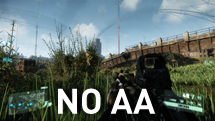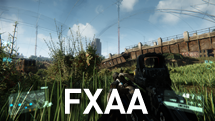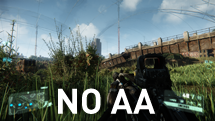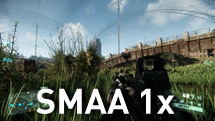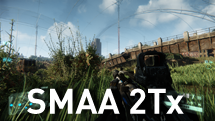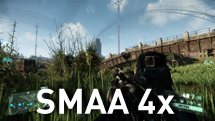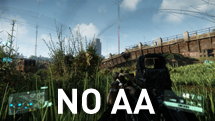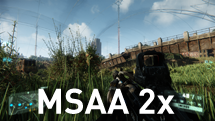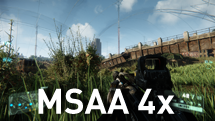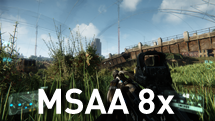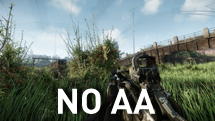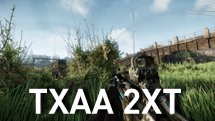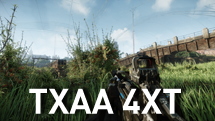Crysis 3 Tweak Guide
[Page 6] Antialiasing
The term Antialiasing (AA) refers to any method that can help smooth out jagged lines, and reduce the distracting shimmering and crawling of those lines when in motion. Crytek has chosen to build several AA methods into Crysis 3: FXAA (Fast Approximate Anti-Aliasing), SMAA (Subpixel Morphological Anti-Aliasing), MSAA (MultiSample Anti-Aliasing), and TXAA (Temporal Anti-Aliasing). The reason for this choice of AA methods is that each has its benefits and drawbacks, both in terms of image quality and performance. There is no single recommended optimal AA method, as it largely depends on a combination of your system's capabilities and personal taste.
FXAA: A very efficient post-process AA technique, FXAA will remove much of the jaggedness from the entire scene with minimal performance impact. The key issue with FXAA is that it can introduce some blurriness.
The screenshots above demonstrate that when FXAA is enabled, much of the harshness is removed from the scene. The bushes to the left, the tall grass, the railings at the top right, and the towers all lose their rather jagged appearance. But there is also some blurring added to the scene - for example, look at the text on the side of the gun. All up though, FXAA addresses aliasing on both foliage and geometry fairly well.
SMAA: A post-process technique similar to FXAA, the SMAA in Crysis 3 has several benefits over its faster brother. Firstly, unlike FXAA, SMAA does not result in any significant blurring. Secondly, there are three different levels of SMAA to choose from in Crysis 3: SMAA Low (1x), SMAA Medium (2Tx) and SMAA High (4x). SMAA 1x is an enhanced form of MLAA (Morphological Anti-Aliasing); SMAA 2Tx is denoted as such because it adds 2x Temporal SSAA (SuperSample Anti-Aliasing) to MLAA to achieve its results; and SMAA 4x is a combination of MLAA, 2x Temporal SSAA and 2x MSAA.
Note: If you run a multi-GPU, the SMAA Medium (2Tx) and SMAA High (4x) options are not available, as they use Temporal Anti-Aliasing which is incompatible with multi-GPU configurations. Instead, you will have an SMAA MGPU (2x) option, which is essentially a combination of MLAA plus 2x MSAA.
The screenshots above show that at SMAA 1x, similar to FXAA, the jaggedness throughout the scene is reduced, both on foliage and various objects, but with no noticeable blurring on textures. However there are still some jagged edges on the railing at the top right, and during gameplay, foliage will still exhibit some aliasing when in motion.
Switching to 2Tx SMAA helps address these problems to a certain extent, further smoothing out jagged outlines, especially on foliage. Unfortunately, using this level of SMAA can result in an oddity that is more noticeable at lower framerates: moving foliage, like waving grass, can leave ghostly trails. This is captured in the screenshots above, where you can see that the moving grass at the bottom left of the screen has double outlines.
Upping the SMAA to 4x improves aliasing once again, most noticeable in our screenshots by looking at the railings at the right just above the gun, and the bush just to the left of center. Once again, you may notice ghosted outlines from moving foliage at lower framerates with this level of SMAA.
MSAA: Multi-Sample Anti-Aliasing (MSAA) is a more traditional and comprehensive, but far more performance-sapping, AA method. It increases the sample rate of data to better render object outlines, reducing their jaggedness. It is available at three sample rates in Crysis 3: MSAA Low (2x), MSAA Medium (4x) and MSAA High (8x). The higher the sample rate, the smoother jagged edges become, at a hefty cost in performance.
In the screenshots above, enabling 2x MSAA at first glance seems to have a similar visual impact to 1x SMAA, except that object outlines such as the railings just above the gun and the structure of the Liberty Dome, are smoother. This is where MSAA excels over the post-process based AA methods like FXAA and SMAA: it addresses geometry aliasing more accurately, which means objects like man-made structures in the game will have smoother edges. This becomes most obvious when you compare the MSAA 8x screenshot with the No AA screenshot - the edges of the towers, Liberty Dome, railings and wrecked train carriage all smooth out considerably.
Interestingly, while MSAA usually doesn't address jagged edges on transparent textures such as foliage, in Crysis 3 the MSAA does exactly that, with the outlines of the grass and bushes clearly affected when MSAA is implemented. Unfortunately, even at the maximum of 8x MSAA, some jaggedness still remains throughout the scene.
TXAA: This option is only available if you are using an NVIDIA GTX 600 series or GTX Titan graphics card. TXAA is based on MSAA, but places greater emphasis on reducing shimmering when in motion, known as temporal aliasing. This distracting shimmering can be particularly disastrous in Crysis 3 multiplayer when you're on the lookout for cloaked enemy nanosuits, which also shimmer. The available options are TXAA Medium (2xT) and TXAA High (4xT).
In the screenshots above, you can see that when enabled, TXAA 2xT does a good job of smoothing out jagged geometry and foliage, and during actual gameplay, it also quashes shimmering from aliasing while in motion. However it does introduce noticeable blurring, similar to FXAA. The difference between TXAA 2xT and 4xT is difficult to see, but if you look at some distant lines, they are slightly smoother with 4xT.
An indication of the performance impact of changing the Antialiasing setting is shown below:

The graph highlights a few interesting points regarding Crysis 3's Anti-aliasing methods:
Since Crysis 3 is quite performance-intensive, for most systems Anti-aliasing of any kind is a luxury. As such, for most people FXAA is recommended as a good compromise of performance and image quality, reducing the harshness of edges at a negligible cost in FPS. If you don't like FXAA's blurring, then substitute SMAA Low (1x). Alternatively, consider using the r_Sharpening command, found in the Advanced Tweaking section, to sharpen the game image to counter the blurring effect of FXAA or TXAA.

